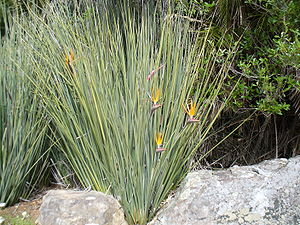Strelitzia juncea
| Strelitzia juncea | ||||||||||||
|---|---|---|---|---|---|---|---|---|---|---|---|---|

Strelitzia juncea |
||||||||||||
| Systematics | ||||||||||||
|
||||||||||||
| Scientific name | ||||||||||||
| Strelitzia juncea | ||||||||||||
| link |
The Strelitzia juncea , seldom called rush-Strelitzia, is a species of Strelitzia ( Strelitzia ) in the Strelitzia family (Strelitziaceae). This South African species is rarely used as an ornamental plant in tropical parks and gardens or as a cut flower.
description
Strelitzia juncea is an evergreen, perennial , herbaceous plant that reaches heights of 1 to 2 meters. It forms clump-like stands and thick, fleshy roots. The basal leaves and are 1 to 2 meters long. In contrast to the other Strelitzia species, no sprouts can be seen. The leaves look rush-like (hence the name). Strelitzia juncea grows slowly and the first inflorescences are only formed after three to four years.
The inflorescences and flowers are very similar to those of Strelitzia reginae . The main flowering period is from May to October. The axillary, upright inflorescence stem is usually slightly shorter than the leaves and has only a few leaves that are reduced to the leaf sheath. The clearly stalked inflorescence forms an angle of about 45 ° upwards from the inflorescence stem and is partially covered by a boat-shaped, approximately 12 to 20 centimeter long bract (the so-called spathe), which usually has red edges. The three bracts are very different in shape and color in the two circles. Of the three mostly bright orange bracts of the outer circle, the middle one is smaller than the lateral ones. Of the three inner, intensely blue bracts, the upper one is short, almost circular and covers the entrance to the “nectar chamber”; the two large lateral ones are fused like an arrow and surround the stylus and the five fertile stamens . They are mainly pollinated by nectar birds (Nectariniidae) or Promeropidae at the natural site .
Woody, triple capsule fruits are formed. The seeds have a woolly aril and are spread by birds.
The number of chromosomes is 2n = 14.
Occurrence
Strelitzia juncea occurs naturally only near Uitenhage , Patensie and a little north of Port Elizabeth in the Eastern Cape Province in South Africa . These natural populations of Strelitzia juncea thrive among drought-resistant plant species such as Euphorbia , Cotyledon , Pelargonium species and Encephalartos horridus . This shows that they can survive with little water. This species survives light frost.
Systematics
Strelitzia juncea was validly first described in 1821 by Heinrich Friedrich Link in Enumeratio Plantarum Horti Regii Berolinensis Altera , 1, p. 150. The specific epithet juncea refers to the rush- like appearance - rushes ( Juncus ).
In 1970 Moore & Hyypio discussed whether Strelitzia reginae var. Juncea ( Ker Gawl. ) HEMoore is a variety of Strelitzia reginae or a separate species. This was decided a short time later, in 1975 by RA Dyer and has since been confirmed several times, in favor of the species Strelitzia juncea Link . Other synonyms for Strelitzia juncea Link are: Strelitzia parvifolia W.T. Aiton var. Juncea Ker Gawl. , Strelitzia principis Andrews ex Spreng. , Strelitzia teretifolia Barrow ex Steud. nom. inval. and Strelitzia reginae subsp. juncea ( Ker Gawl. ) Sm.
literature
- John Winter: www.plantzafrica.com/plantqrs/strelitzjun.htm Strelitzia juncea at plantzafrica.com of the Kirstenbosh Botanical Garden. (Section Description and Occurrence)
- Harold E. Moore, Jr. & Peter A. Hyypio: Some Comments on Strelitzia (Strelitziaceae) , in Baileya , 17, 1970, pp. 65-75.
- Gordon Cheers (Ed.): Botanica , Random House Australia, 2003. German edition: Tandem Verlag GmbH, 2003, ISBN 3-8331-1600-5 .
Individual evidence
- ↑ Strelitzia juncea at Tropicos.org. In: IPCN Chromosome Reports . Missouri Botanical Garden, St. Louis
- ^ RA Dyer: Notes on African plants: Strelitziaceae. The status of Strelitzia juncea. In: Bothalia , Volume 11, Number 4, 1975, pp. 519-520. ( PDF )
- ^ TH Arnold & BC De Wet (editors): Plants of southern Africa: names and distribution. , in Mem. Bot. Surv. S. Africa , No. 62, 1993.
- ↑ G. Germishuizen & NL Meyer (editor): Plants of southern Africa: an annotated checklist , In: Strelitzia , 14, 2003.
